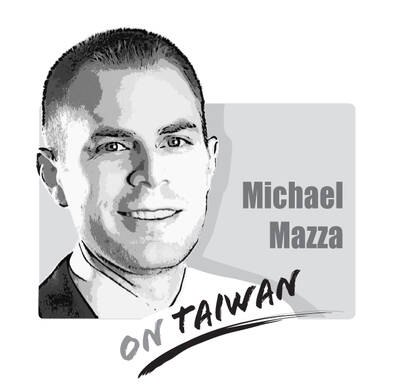China’s “zero COVID-19” policy and strict lockdowns have dealt a serious blow to manufacturers, and could hasten the exit of foreign firms amid mounting operational risks and a deteriorating investment environment. Taiwanese electronics manufacturers, in particular, have suffered, as China remains a major production hub, although many have gradually relocated operations back to Taiwan or to other countries, as the US-China trade row reshapes global supply chains.
Taiwanese notebook computer makers have been forced to suspend production and have encountered difficulties shipping finished goods to customers, as the Chinese government strictly prohibits human contact and movement to curb the spread of COVID-19. The lockdowns’ effects can be seen in the revenue reports for last month of the world’s top two notebook computer makers. Quanta Computer Inc’s sales plummeted 39.5 percent to NT$66.73 billion (US$2.24 billion), while Compal Electronics Inc’s declined 47.53 percent to NT$53.92 billion.
Likewise, Pegatron Corp, which assembles iPhones and notebook computers, last week slashed its forecast for notebook computer shipments this quarter to a sequential decline of 5 to 10 percent. That compares with its previous guidance of an expansion of between 25 and 30 percent.
Quanta and Compal make notebook computers in Shanghai; Kunshan, Jiangsu Province; and Chongqing, Sichuan Province. The two companies have in the past few years joined other Taiwanese electronics makers, such as Pegatron and Hon Hai Precision Industry Co, in shifting offshore production to Southeast Asian countries, including Vietnam and Thailand, and India.
Expanding its reach to key component semiconductors for vehicles, Hon Hai said its semiconductor deployment in India is picking up pace, matching global peers’ expansion there. Supply chains are becoming “shorter” or “localized” due to COVID-19 pandemic restrictions and logistics snarls, the company said. That means local supply is becoming essential during the pandemic when port congestion and transportation chaos paralyze production.
The shift is spreading to the whole electronics supply chain. Lite-On Technology Corp, which supplies power units and other components, said that its “China-plus-one” strategy aims to diversify and balance its supply chain by avoiding an overconcentration on China.
“In addition to cost surges in overland and air transportation, we spent most of our time figuring out how to reroute goods to customers’ production bases that are less affected by the lockdowns,” Lite-On president Anson Chiu (邱森彬) told investors in a virtual conference last month.
Lite-On said it is ramping up plans to build new manufacturing facilities in Thailand. This year, it is also to start a phase-two capacity expansion in Vietnam to make notebook computers and networking components. The company is making inroads into the US by setting up new production lines to manufacture power management units used in electric vehicle chargers and other components for US customers. At home, a new capacity expansion plan is to start later this year in Kaohsiung.
As of early this month, the government’s “Invest in Taiwan” initiative has attracted 1,191 Taiwanese companies investing up to NT$1.68 trillion, the Ministry of Economic Affairs said, adding that the projects would create 21,801 jobs.
Given the dynamic changes in global supply chains, Taiwanese manufacturers are facing labor management challenges and issues such as how fast they can ramp up new production in new, unfamiliar territories. It will take time to reshape the whole supply chain, but if they can overcome those challenges, they should be able to embrace a new wave of growth.

Could Asia be on the verge of a new wave of nuclear proliferation? A look back at the early history of the North Atlantic Treaty Organization (NATO), which recently celebrated its 75th anniversary, illuminates some reasons for concern in the Indo-Pacific today. US Secretary of Defense Lloyd Austin recently described NATO as “the most powerful and successful alliance in history,” but the organization’s early years were not without challenges. At its inception, the signing of the North Atlantic Treaty marked a sea change in American strategic thinking. The United States had been intent on withdrawing from Europe in the years following
My wife and I spent the week in the interior of Taiwan where Shuyuan spent her childhood. In that town there is a street that functions as an open farmer’s market. Walk along that street, as Shuyuan did yesterday, and it is next to impossible to come home empty-handed. Some mangoes that looked vaguely like others we had seen around here ended up on our table. Shuyuan told how she had bought them from a little old farmer woman from the countryside who said the mangoes were from a very old tree she had on her property. The big surprise
The issue of China’s overcapacity has drawn greater global attention recently, with US Secretary of the Treasury Janet Yellen urging Beijing to address its excess production in key industries during her visit to China last week. Meanwhile in Brussels, European Commission President Ursula von der Leyen last week said that Europe must have a tough talk with China on its perceived overcapacity and unfair trade practices. The remarks by Yellen and Von der Leyen come as China’s economy is undergoing a painful transition. Beijing is trying to steer the world’s second-largest economy out of a COVID-19 slump, the property crisis and
As former president Ma Ying-jeou (馬英九) wrapped up his visit to the People’s Republic of China, he received his share of attention. Certainly, the trip must be seen within the full context of Ma’s life, that is, his eight-year presidency, the Sunflower movement and his failed Economic Cooperation Framework Agreement, as well as his eight years as Taipei mayor with its posturing, accusations of money laundering, and ups and downs. Through all that, basic questions stand out: “What drives Ma? What is his end game?” Having observed and commented on Ma for decades, it is all ironically reminiscent of former US president Harry